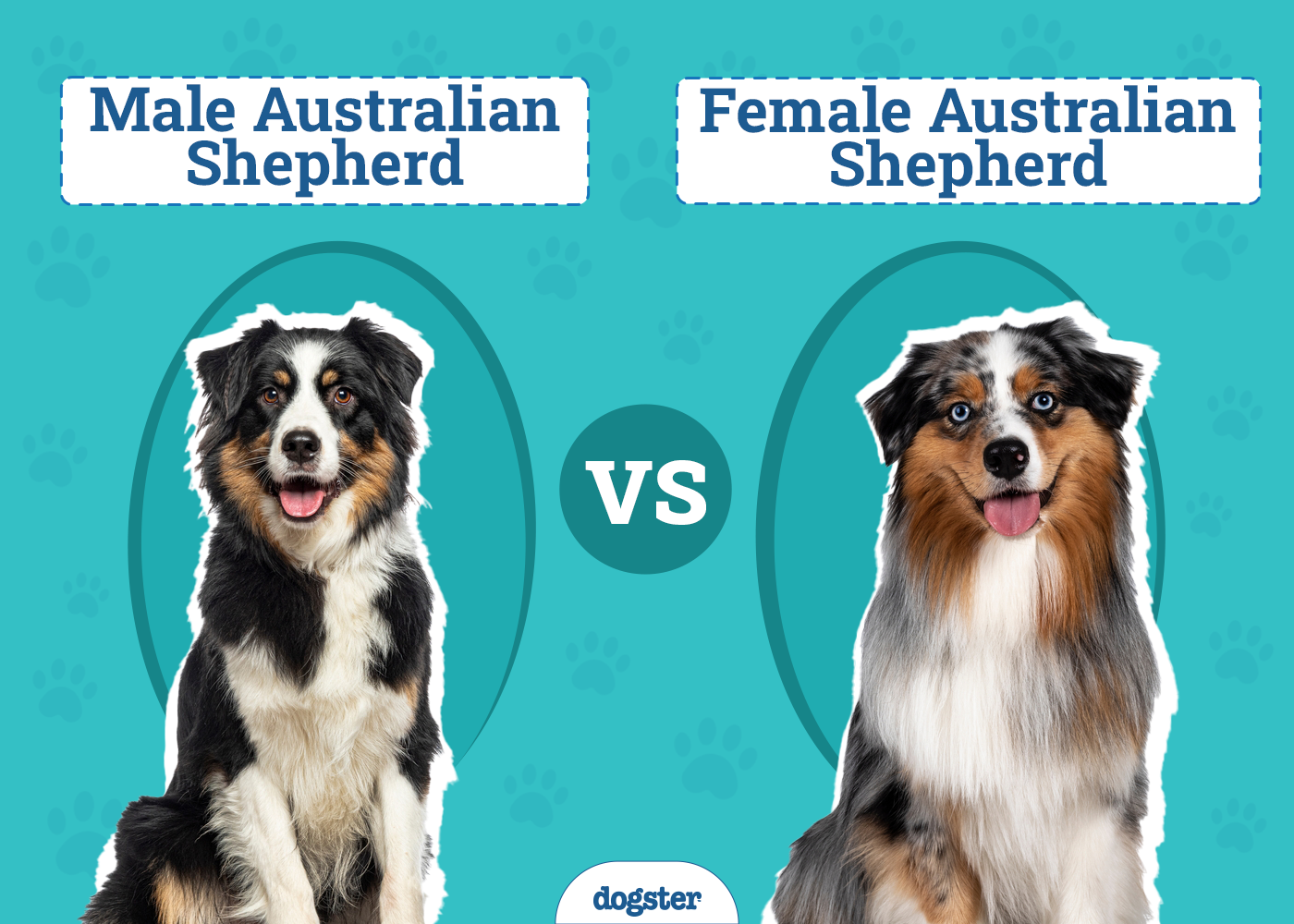In this article
Australian Shepherds are adventurous dogs that love the companionship of humans. They get along well with kids and other animals, and their intelligence tends to make training easy. While both male and female Australian Shepherds share many of the same personality and temperament traits, there are a few distinctive differences between the two sexes that should be known before deciding which sex to adopt as a pet for your household. It also doesn’t hurt to learn about the similarities between the sexes. Here is all the information that you need to know about the difference between male and female Australian Shepherds.

Visual Differences

Both male and female Australian Shepherds are similar in terms of appearance. They share the same coat types and physical features overall, but they do differ in weight and height. Males are usually a couple of inches taller and up to 10 pounds heavier than females. Females have 10 teats on their bellies, while males do not, but it can be almost impossible to see or feel those teats until the dog becomes pregnant. Since the visual characteristics of male and female Australian Shepherds are so similar, the only real way to tell the difference is to check the genitals.
At a Glance
- Average height (adult): 20–23 inches
- Average weight (adult): 50–65 pounds
- Average height (adult): 18–21 inches
- Average weight (adult): 40–55 pounds

Australian Shepherds 101

Australian Shepherds have muscular bodies in general. They have smooth gaits and display agile movements while running and playing. These dogs typically have triangular-shaped ears and broad chests. Most Australian Shepherds are naturally inclined to herd, which is what they were originally developed to do. They tend to have a great deal of energy throughout the day, and they love to play, whether with other dogs or human companions.
This breed is intelligent and can successfully take on multiple types of training, including obedience, agility, and even watchdog training. Their endurance makes them excellent sporting dogs that can swim, hike, and run with the best of them. Due to their disciplined natures and affectionate personalities, these dogs are sometimes used as rescue or therapy workers.
Male Australian Shepherd Overview

Personality / Character
Male Australian Shepherds tend to be more outgoing than females, and they spend more time vying for the attention of family members. While both sexes are active, males are usually more curious and restless than their female counterparts, especially when nothing exciting seems to be going on. Males are usually more affectionate to human companions and are more likely to follow their owners around.
Training
Training is an essential part of successfully raising an Australian Shepherd, which the boys are thought to be better at because they usually (not always!) have a bigger desire to please their owners. Both male and female Australian Shepherds enjoy multiple types of training, but the boys tend to excel at agility training more than the girls. Also, due to their playful nature and intense curiosity, males are usually more eager to try new things during training.
Health & Care
Both male and female Australian Shepherds are generally healthy and have about the same life expectancy of between 12 and 15 years. This is not a hard-and-fast rule, so some dogs live a shorter life and some live longer, no matter their sex. There are certain health conditions that male Australian Shepherds are susceptible to that female Australian Shepherds are not, which include:
- Prostatic hyperplasia
- Testicular cancer
Having a male neutered can help reduce the risk of the dog developing these harsh health conditions as time goes on. The best time to neuter a male Australian Shepherd is while they are still a puppy — a veterinarian should be consulted for a recommended timeline.

Breeding
Males Australian Shepherds tend to become sexually mature at around 1 year old. They can breed at any time throughout the entire year, so they tend to try to run off to find females if there is no one at home to mate with. If an unneutered dog cannot mate when they detect that a female is around, they can become agitated, start whining, or even refuse to eat their meals.
- Eager to please
- Curious and outgoing
- Affectionate and loyal
- Requires plenty of daily exercise
- They’re larger and therefore, require more food than females

Female Australian Shepherd Overview

Personality / Character
Female Australian Shepherds are affectionate with their human companions, but their attitude is more like “you love me” as opposed to the “I love you” mentality of the typical male. Females are a bit more independent than males and do not require as much attention or praise. Both sexes are active, but females seem to enjoy a slower-paced exercise and playtime regimen. Females are more sensitive, especially when it comes to who and what is encroaching on their territory.
Training
Females are just as smart as males, but they are not as eager to train. Therefore, they require a little more patience and practice time. Females understand training, they are just not as interested in it as males tend to be. Some trainers find that females can learn the commands quicker than males, even if they do not follow directions as often.
Health & Care
Like male Australian Shepherds, females are usually healthy throughout their life, provided that they are properly cared for. However, there are a couple of health conditions that are specific to females:
- Mammary cancer
- Uterine infections
A low-salt diet and regular checkups at the veterinarian’s office will help ensure that these problems do not develop at any time in a female Australian Shepherd’s life. It is better to take proactive steps than to wait until signs of these issues show up. The sooner that the problems are addressed, the better chance the dog has of recovering.

Breeding
Female Australian Shepherds typically start having heat cycles at about 1 year old. From then on, she will go into heat twice a year unless she is spayed. The heat cycle lasts for about 3 weeks, during which time a female will actively look for a male to mate with. Affection and physical touch tend to increase during the heat cycle, which can be a surprise to owners the first or second time around.
- Independent and trustworthy
- Protective of family members
- Gentler with children than males are
- Can be territorial at home
- Not as affectionate as males

Which Sex Is Right for You?
The decision of which sex of Australian Shepherd to adopt comes down to personal preference. If you’re looking for a fun-loving, goofy dog that yearns for affection and attention, a male Australian Shepherd is a good fit. If you are more interested in a loving yet independent dog that does not mind spending time alone, a female might be a better fit. No matter what your decision is, you’re sure to love the loyalty, excitement, and camaraderie that your new Australian Shepherd brings to your household environment.
See Also:
- American Shepherd vs Australian Shepherd: Which One is Right for You? (With Pictures)
- Why Do Male Dogs Have Nipples? Explanation & 6 Possible Concerns
Featured Image Credit: Top – xkunclova, Shutterstock | Bottom – Medenka Nera, Shutterstock



















